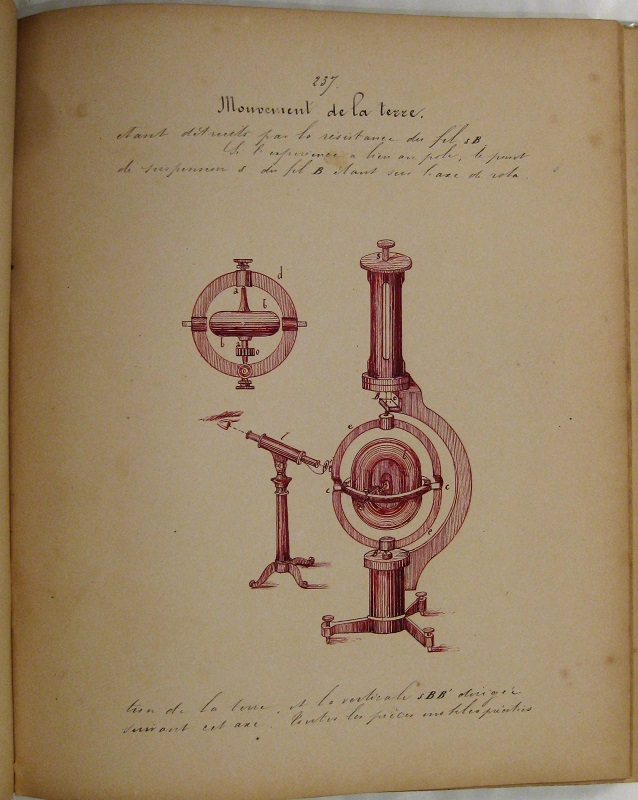![img_6936]()
“Cosmographie”, 4to (25×20 cm), [2] and 512 pages ; contemporary black half-leather.
Even if the general title is “Cosmographie” the manuscript deals with several different subjects : scientific instruments illustrated with 96 drawings ; measurements of the movements of the earth and measurements of the position of the stars with 28 drawings ; description of the celestial chart and stars with 25 drawings and a celestial chart in two parts drawn and handcoloured ; earth (form, movement, longitude, latitude, meridian) and measurements of its movements with 25 drawings ; geographic maps and cartography (different projections, how to draw maps, etc.) with 30 drawings ; atmosphere of the earth with 5 drawings ; description of the sun (diameter, movements, chemical composition, solar time) with 13 drawings ; dialling with 9 drawings.
This manuscript was written for the programme of the Scientific Baccaulaureat in the 1860s'. Indeed, pages 184, 310 and 446 give the details and contents of a "Programme" in 17 points which matches perfectly with the new scientific programme decreed by the French Government in 1859/1860.
Therefore we can suppose that it was, either a project for a new publication, or the personal manuscript of a teacher for the preparation of his lectures.
The first hypothesis is more probable : indeed, the quality of the technical drawings seems to indicate that they were meant to be engraved.
For the redaction of his own textbook the author/writer used at least 4 different sources.
Below, the details of the sources corresponding to each section of the large manuscript :
-pages 1-60 : based on Delaunay, Cours élémentaire d'astronomie, 1860 ;
-pages 61-99 : based on Ganot, Traité élémentaire de physique expérimentale, 1859 with a lot of additionnal calculuses and a complete new organisation of the contents ;
-pages 100-112 : based on Delaunay ;
-pages 112-129 : mixed between Delaunay and Ganot with some additions ;
-pages 130-181 : based on Delaunay ;
-pages 185-213 : based on Marquet, Leçons nouvelles de cosmographie, 1864 with additional drawings and short texts. We can notice also that the drawings are more sophisticated than Marquet's engravings. Furthermore there are two full-page drawings (pages 205 and 209 coming from Delaunay) ;
-pages 213-216 : based on Delaunay ;
-pages 217-220 : based on Marquet ;
-pages 221-239 : based on Marquet for the 4 first then on Delaunay with a superb full-page drawing in red of Foucault's gyroscope ;
-pages 240-260 : based on Marquet ;
-pages 247-277 : based on Marquet BUT with additions of text and drawings of figurative constellations which are original and unpublished ;
-pages 277-308 : mixe sources between Marquet and Delaunay ;
-pages 311-325 : based on Marquet with additionnal drawings and additionnal text ;
-pages 325-329 (Usages du sextant) : based on Marquet without addition ;
-pages 329-346 : based on Marquet with used of Guillmin, Leçon de cosmographie, 1860 for pages 338 to 345 ("Signaux astronomiques" to "tropiques, cercles polaires");
-pages 347-371 : based on Marquet with one additional drawing and a short text ;
-pages 372-412 : based on Marquet with five additionnal drawings (pages 377, 390, 396, 403 and 409).
-pages 413-444 : based on Marquet with one additionnal drawing (page 424) ;
-pages 447-512 : based on Marque with one additionnal drawing (pages 454).
As indicated previously in the detailed listing, the part concerning the stars and the celestial chart is very innovative in its presentation. This part is illustrated with individual drawings of every major constellation : the writer cut out each constellation from a printed celestial map then drew their symbolic representations with different colours. We did not find such a presentation in the contemporary textbooks or in any of those published during the 19 th century. This particular layout underlines the pedagogical effort provided by the teacher for his students.
As explained before this manuscript is based on contemporary textbooks copying some usual/classic illustrations.
However, the texts used are entirely rewritten and the general organisation of the work completely new.
A splendid and richly illustrated example of an unpublished and anonymous French textbook about scientific instruments and general astronomy.
The post A richly illustrated unpublished French manuscript on scientific instruments, astronomy, cartography, surveying and dialling, circa 1860 appeared first on Fleaglass.

































